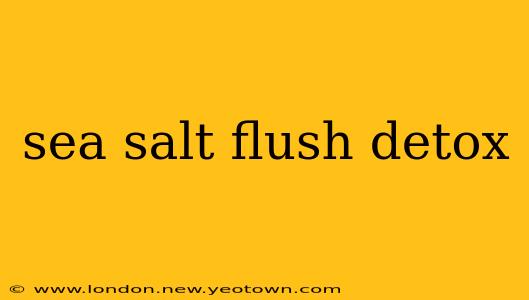The internet is buzzing with claims about the miraculous cleansing power of a sea salt flush detox. But is this trendy health practice all it's cracked up to be? Let's dive deep into the world of sea salt flushes, separating fact from fiction and exploring the potential benefits and risks involved. This isn't about promoting a quick fix, but rather understanding the science behind the claims and making informed decisions about your health.
My name is Alex, and I've spent years researching natural health remedies and holistic wellness practices. While I always advocate for a balanced approach to health, including regular exercise and a nutritious diet, I believe in empowering people with knowledge to make choices that are right for them.
What is a Sea Salt Flush Detox?
The basic premise of a sea salt flush is simple: dissolving a specific amount of sea salt in water and drinking it to supposedly cleanse the body. Proponents claim this promotes detoxification by flushing out toxins and improving bowel movements. The sea salt, often Himalayan pink salt or Celtic sea salt, is believed to draw water into the intestines, leading to a laxative effect.
Does a Sea Salt Flush Actually Detoxify Your Body?
This is where things get complicated. While our bodies possess natural detoxification mechanisms (liver, kidneys, skin, and lymphatic system), the idea that a simple sea salt flush can significantly enhance or accelerate this process is largely unsubstantiated. The body's inherent detoxification systems are highly efficient, and there's little scientific evidence to support the extraordinary claims made about sea salt flushes.
What are the Potential Benefits of a Sea Salt Flush?
While a sea salt flush isn't a magical detox, there are a few potential, albeit limited, benefits:
- Relief from Constipation: The laxative effect of the sea salt can provide temporary relief from constipation. However, this is a temporary solution, and relying on it regularly can lead to dependency and electrolyte imbalances.
- Electrolyte Replenishment (in moderation): Sea salt contains electrolytes like sodium and chloride, which are essential for bodily functions. However, consuming excessive amounts can be detrimental to health. A balanced diet usually provides sufficient electrolytes.
What are the Risks Associated with Sea Salt Flushes?
The potential downsides outweigh any perceived benefits, especially with frequent use:
- Electrolyte Imbalance: Consuming too much salt can disrupt the delicate balance of electrolytes in your body, leading to potentially dangerous consequences like dehydration, nausea, vomiting, and even irregular heartbeat.
- Dehydration: While a sea salt flush is intended to hydrate, the osmotic effect can actually lead to dehydration if not carefully managed and if sufficient water isn't consumed concurrently.
- Diarrhea: The laxative effect can cause diarrhea, leading to discomfort, dehydration, and potential nutrient loss.
- Kidney Problems: Individuals with existing kidney problems should avoid sea salt flushes, as they can put extra strain on the kidneys.
- Medication Interactions: Sea salt flushes might interact negatively with certain medications, so consult your doctor if you are on any medications.
How Much Sea Salt Should I Use in a Flush?
There's no universally agreed-upon amount of sea salt for a flush. The recipes and suggestions available online vary considerably. This lack of standardization highlights the absence of robust scientific backing. The crucial point is to avoid excessive salt intake.
Can a Sea Salt Flush Help with Weight Loss?
Many proponents claim sea salt flushes aid in weight loss. However, this is largely a misconception. Any temporary weight loss experienced is likely due to fluid loss, not actual fat reduction. This weight will be quickly regained once normal hydration is restored. Sustainable weight loss requires a balanced diet and regular exercise.
Is Sea Salt Flush Safe for Everyone?
No, a sea salt flush is not safe for everyone. Pregnant women, breastfeeding mothers, individuals with kidney problems, heart conditions, or those on certain medications should absolutely avoid sea salt flushes without first consulting their doctor.
Conclusion: A Balanced Approach to Wellness
While a sea salt flush might offer temporary relief from constipation, the potential risks significantly outweigh the benefits. Sustainable health and wellness come from a balanced lifestyle, including a nutritious diet, regular exercise, adequate hydration, and stress management. Instead of relying on quick fixes like sea salt flushes, focus on building healthy habits for long-term well-being. Always consult with your healthcare provider before making significant changes to your diet or health routine.

